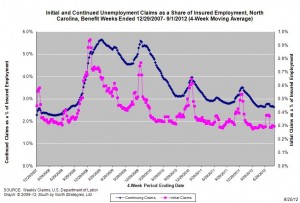Summer Doldrums Hit State’s Job Market
CHAPEL HILL (September 21, 2012) – North Carolina recorded no net job growth in August, as a decline in private-sector payrolls offset most of an increase in public-sector job levels. Over the month, the state gained 1,100 more payroll jobs than it lost (+/-0.0 percent). Meanwhile, the number of unemployed North Carolinians and the statewide unemployment rate rose. These findings come from new data released by the Labor and Economic Analysis Division of the NC Department of Commerce.
“North Carolina’s labor market drifted through August,” said John Quinterno, a principal with South by North Strategies, Ltd., a research firm specializing in economic and social policy. “The overall number of jobs in the state held steady at slightly under 4 million, while the number of unemployed persons rose for the third consecutive month. Similarly, the unemployment rate rose for the second straight month and returned to a level last seen in March 2012.”
In August, North Carolina employers added 1,100 more jobs than they cut (+/-0.0 percent). Public-sector payrolls netted 8,400 positions (+1.2 percent), with local governments responsible for 73.8 percent of that gain (note that public-sector payroll figures can be volatile in the summer months). Private-sector payrolls, however, shed 7,300 more positions than they added (-0.2 percent). Within the private sector, construction lost the most jobs (-3,400, -2 percent), followed by the trade, transportation, and utilities sector (-2,500, -0.3 percent) and manufacturing (-2,300, -0.5 percent). The other services sector netted the most jobs (+1,200, +0.8 percent), followed by professional and business services (+800, +0.2 percent) and education and health services (+600, +0.1 percent).
A negative revision to the July payroll data found that the state lost rather than gained jobs (-2,600 versus +1,800). With that revision, North Carolina now has, on net, 223,300 fewer payroll positions (-5.4 percent) than it did in December 2007. Since bottoming out in February 2010, the state has netted an average of 3,433 payroll jobs per month, resulting in a cumulative gain of 103,000 positions (+2.7 percent).
“North Carolina’s labor market started 2012 strongly, but it has lost energy over the course of the year,” noted Quinterno. “Since March, the state’s labor market has given back 22.1 percent of the job gains recorded during the first quarter of the year. Both the private and public sectors have struggled as the year has progressed, and the bottom line is that the state is not generating enough jobs to accommodate all those North Carolinians who want and need work.”
The household data for August provided further evidence of a struggling labor market. Last month, the unemployment rate rose to 9.7 percent, which was the highest level recorded since March, and the number of unemployed persons grew by 1.3 percent. Compared to July, 5,952 more North Carolinians were unemployed, and 5,801 fewer persons (-0.1 percent) reported having jobs. Also, the size of the labor force essentially held steady (+151 persons).
Over the past year, the total number of unemployed North Carolinians has fallen by 47,538 persons (-9.5 percent), and the number of employed persons has grown by 40,635 persons (+1 percent). The remaining 6,903 persons appear to have left the labor force (-0.1 percent) for one reason or another.
That said, the increase in employment is weak relative to the severity of the labor market problems facing the state. North Carolina’s unemployment rate has exceeded 9 percent in every month since January 2009 and has ranged as high as 11.4 percent. Compared to December 2007, which was when the “Great Recession” began, the statewide unemployment rate is 4.7 percentage points higher, while the number of unemployed North Carolinians is 97.5 percent greater. During the first eight months of 2012, an average of 450,517 North Carolinians were unemployed in any given month.
Other troubling labor market indicators include a statewide unemployment rate that has exceeded 10 percent in 35 of the last 44 months, a labor force participation ratio that has fallen steadily over the course of the year and is hovering near a 36-year low, and an extremely depressed employment-to-population ratio. Last month, just 56 percent of working-age North Carolinians were employed, a level up only somewhat from the modern low of 55.3 percent set in late 2011.
“Job growth in North Carolina has decelerated over the course of 2012,” observed Quinterno. “While the private-sector has expanded, the bottom line is that the state has just 0.5 percent more jobs than it did last December and only 0.7 percent more jobs than it did one year ago. North Carolina remains mired in a jobless recovery and little appears likely to alter that reality in the near future.”


 Email Sign-Up
Email Sign-Up RSS Feed
RSS Feed